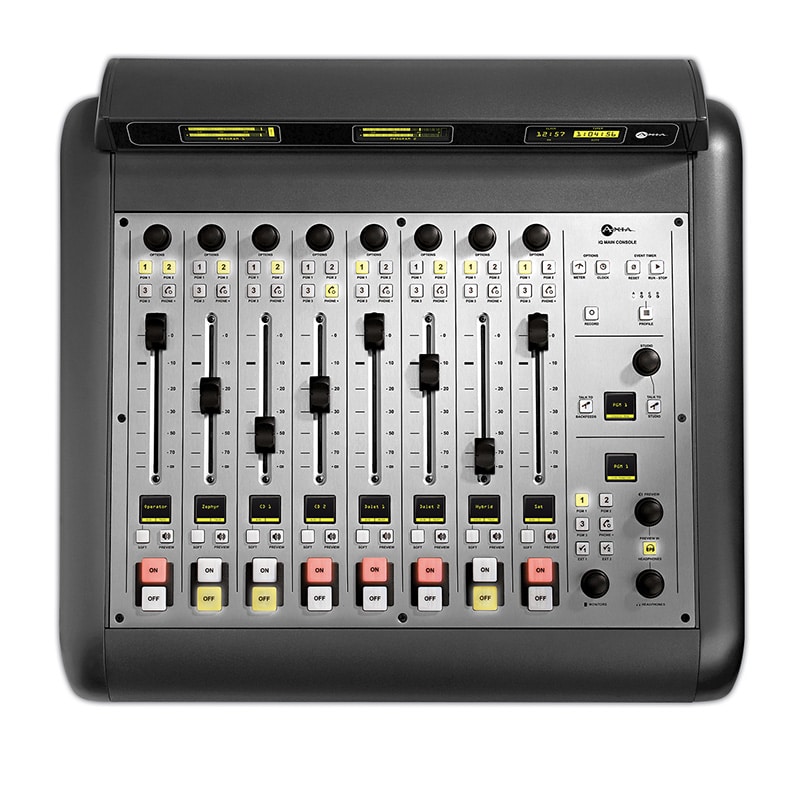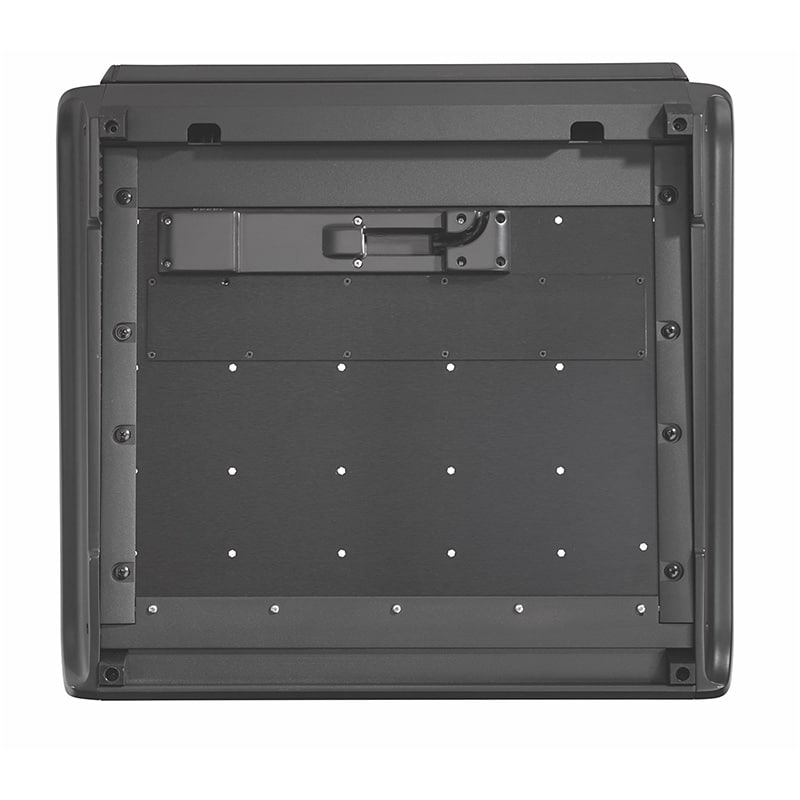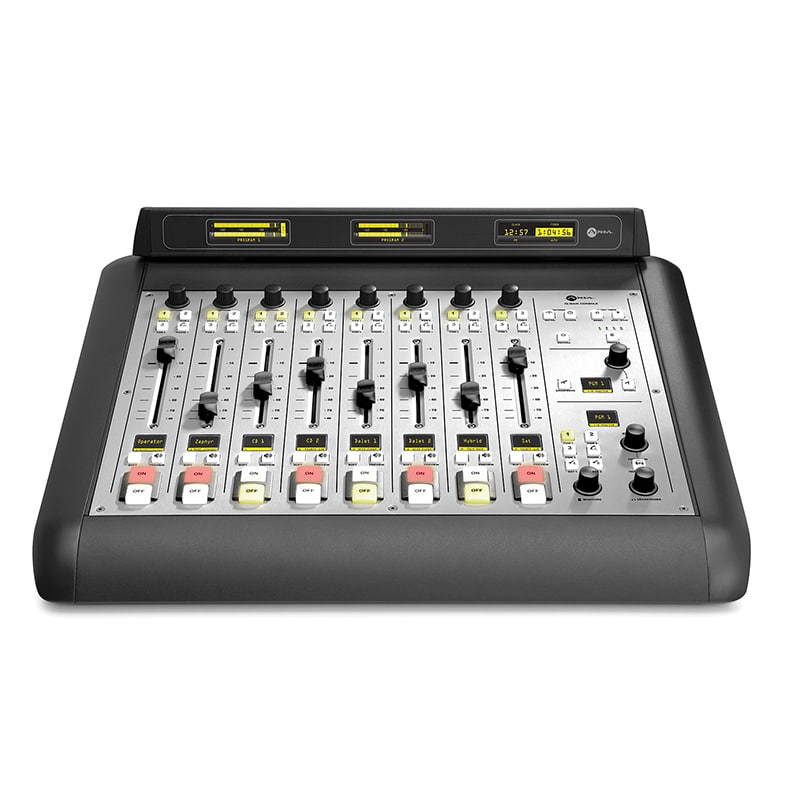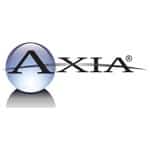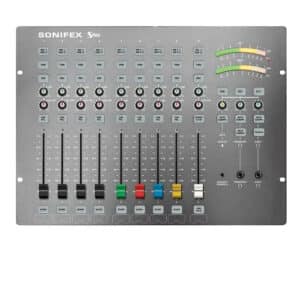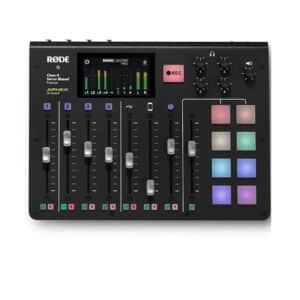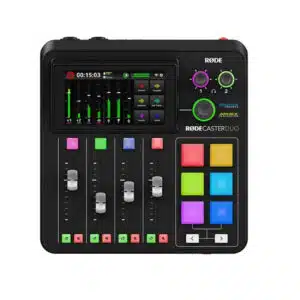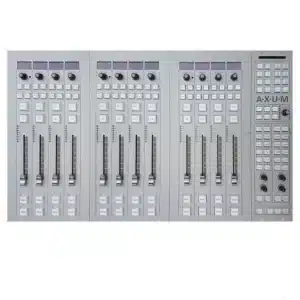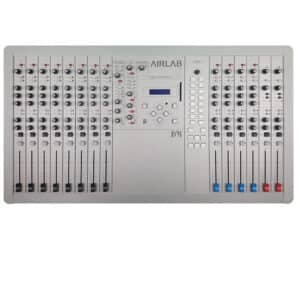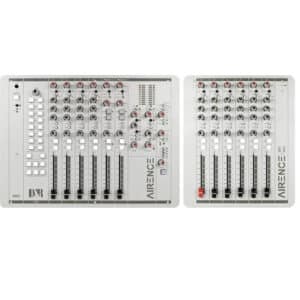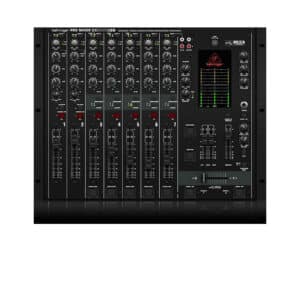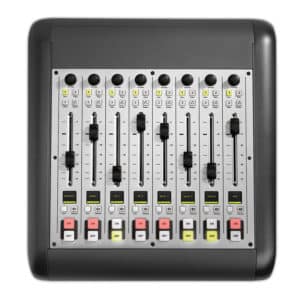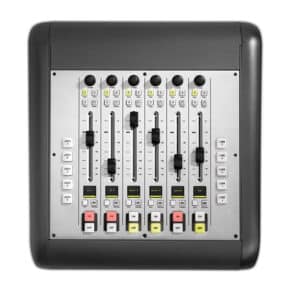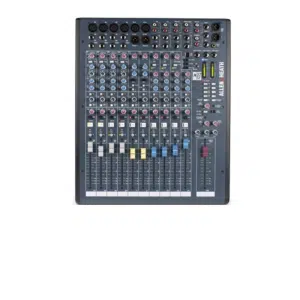Description
Axia iQ Main Frame 8-fader mixer
Axia iQ, the new IP-Audio console from Axia Audio. Everything’s included: control surface, DSP-based mixing engine, audio I/O, machine-control logic, even an Ethernet switch custom-built for IP-Audio. There’s an available backup power supply, too. Setup couldn’t be simpler: connect the iQ control surface to the Core engine with a single cable, add audio inputs using CAT-5, perform some fast Web-based configuration, and your iQ system is ready to broadcast. It really is that simple.
Axia iQ radio console system can be used to build custom consoles of sizes from 8 to 24 faders. A basic system consists of one iQ 8-Fader Main Frame and one QOR.32 integrated console engine, a DSP- based mixing engine which also incorporates analog and digital audio I/O, GPIO and a custom, zero- configuration Ethernet switch. Faders and control capabilities can be expanded by adding one or more iQ Expansion Frames (up to a maximum of 3 frames per console installation). iQ console frames may be placed on top of desk surface, or mounted drop-in style. Multiple frames may be physically joined if desired.
iQ operates as a standalone console, but can also connect to Axia networks. The iQ mixing surface plugs into the QOR.32 engine using a single cable. Setup couldn’t be simpler: connect the iQ control surface to the QOR.32, add audio inputs using CAT-5, perform some fast Web-based configuration, and your iQ system is ready to broadcast.
iQ features 3 dedicated stereo Program buses, plus a stereo Utility bus that can be used for phone calls, off-air recording, or as a fourth Program bus. Automatic mix-minus is provided on each fader, plus talkback functions, one-button off-air Record Mode, Show Profile functions for instant recall of up to 4 pre-defined console “snapshots”, high-resolution OLED program meters switchable between VU and PPM metering styles, OLED option and source name displays on each fader strip, Studio and Control Room monitor controls. Add redundant power to your iQ system with the Axia Console Power Supply. This single-cable connection to the QOR.32 console engine provides backup power with automatic switching.
SPECIFICATIONS QOR.32
Connections
• Microphone Inputs: 4x balanced XLR-F, with selectable Phantom power
• Analog Inputs: 16x RJ-45, StudioHub+ standard. • Analog Outputs: 8x RJ-45, StudioHub+ standard.
• AES/EBU Inputs: 2x RJ-45, StudioHub+ standard. • AES/EBU Outputs: 2x RJ-45, StudioHub+ standard.
• GPIO: 8x DB-15 • Livewire:
• 4x 100BASE-T with PoE, RJ-45
• 2x 100BASE-T, RJ-45 • 2x 1000BASE-T, RJ-45
• 2x Gigabit, SFP (Small Form Pluggable) • Console Frame Connections: 3x, 6-pin “latch and lock” style
• Accessory Connections: 1x, 6-pin “latch and lock” style
Microphone Preamplifiers
• Source Impedance: 150 Ohms • Input Impedance: 4 k Ohms minimum, balanced
• Nominal Level Range: Adjustable, -75 dBu to -20 dBu
• Input Headroom: >20 dB above nominal input
• Output Level: +4 dBu, nominal Analog Line Inputs
• Input Impedance: 20 k Ohms
• Nominal Level Range: Selectable, +4 dBu or -10dBv
• Input Headroom: 20 dB above nominal input
Analog Line Outputs
• Output Source Impedance: <50 Ohms balanced
• Output Load Impedance: 600 Ohms, minimum • Nominal Output Level: +4 dBu
• Maximum Output Level: +24 dBuAxia iQ | The Smarter IP Console TelosAlliance.com/Axia/iQ
Digital Audio Inputs And Outputs
• Reference Level: +4 dBu (-20 dB FSD)
• Impedance: 110 Ohm, balanced (XLR)
• Signal Format: AES-3 (AES/EBU)
• AES-3 Input Compliance: 24-bit with selectable sample rate conversion, 20 kHz to 216kHz input sample rate capable.
• AES-3 Output Compliance: 24-bit
• Digital Reference: Internal (network timebase) or external reference 48 kHz, +/- 2 ppm
• Internal Sampling Rate: 48 kHz
• Output Sample Rate: 48 kHz
• A/D Conversions: 24-bit, Delta-Sigma, 256x oversampling
• D/A Conversions: 24-bit, Delta-Sigma, 256x oversampling
• Latency <3 ms, mic in to monitor out, including network and processor loop
Frequency Response
• Any input to any output: +0.5 / -0.5 dB, 20 Hz to 20 kHz
Dynamic Range
• Analog Input to Analog Output: 102 dB referenced to 0 dBFS, 105 dB “A” weighted to 0 dBFS
• Analog Input to Digital Output: 105 dB referenced to 0 dBFS
• Digital Input to Analog Output: 103 dB referenced to 0 dBFS, 106 dB “A” weighted
• Digital Input to Digital Output: 125 dB Equivalent Input Noise
• Microphone Preamp: -128 dBu, 150 Ohm source, reference -50 dBu input level Total
Harmonic Distortion + Noise
• Mic Pre Input to Analog Line Output: <0.005%, 1 kHz, -38 dBu input, +18 dBu output
• Analog Input to Analog Output: <0.008%, 1 kHz, +18 dBu input, +18 dBu output
• Digital Input to Digital Output: <0.0003%, 1 kHz, -20 dBFS
• Digital Input to Analog Output: <0.005%, 1 kHz, -6 dBFS input, +18 dBu outputAxia iQ | The Smarter IP Console TelosAlliance.com/Axia/iQ
Crosstalk Isolation, Stereo Separation And CMRR
• Analog Line channel to channel isolation: 90 dB isolation minimum, 20 Hz to 20 kH
• Microphone channel to channel isolation: 80 dB isolation minimum, 20 Hz to 20 kHz
• Analog Line Stereo separation: 85 dB isolation minimum, 20Hz to 20 kHz
• Analog Line Input CMRR: >50 dB, 20 Hz to 20 kHz Microphone Input CMRR: >50 dB, 20 Hz to 20 kHz
Audio Processing
• Mic Equalizer (applicable to up to 6 faders)
• Frequency Bands: 20Hz to 320Hz, 125Hz to 2KHz, 1.25KHz to 20KHz.
• Cut/Boost range on each band: -25dB to +15dB.
• Q-factor: Automatic – bandwidth varies based on amount of cut or boost.
Power Supply AC Input, QOR.32 with iQ Console
• Auto-sensing supply, 90VAC to 240VAC, 50 Hz to 60 Hz, IEC receptacle, internal fuse
• Power consumption: 100 Watts Operating
Temperatures
• -10 degrees C to +40 degrees C, <90% humidity, no condensation
Dimensions
• iQ Main Frame 20.5” x 19” x 4.5” (52,07 cm x 48,26 cm x 11,43 cm) (desktop to meter bridge)
• iQ Expansion Frames 17.5” x 18.25” x 3”(44,45 cm x 46,36 cm x 7,62 cm) (desktop to tallest control)
- Description
-
Axia iQ Main Frame 8-fader mixer
Axia iQ, the new IP-Audio console from Axia Audio. Everything’s included: control surface, DSP-based mixing engine, audio I/O, machine-control logic, even an Ethernet switch custom-built for IP-Audio. There’s an available backup power supply, too. Setup couldn’t be simpler: connect the iQ control surface to the Core engine with a single cable, add audio inputs using CAT-5, perform some fast Web-based configuration, and your iQ system is ready to broadcast. It really is that simple.
Axia iQ radio console system can be used to build custom consoles of sizes from 8 to 24 faders. A basic system consists of one iQ 8-Fader Main Frame and one QOR.32 integrated console engine, a DSP- based mixing engine which also incorporates analog and digital audio I/O, GPIO and a custom, zero- configuration Ethernet switch. Faders and control capabilities can be expanded by adding one or more iQ Expansion Frames (up to a maximum of 3 frames per console installation). iQ console frames may be placed on top of desk surface, or mounted drop-in style. Multiple frames may be physically joined if desired.
iQ operates as a standalone console, but can also connect to Axia networks. The iQ mixing surface plugs into the QOR.32 engine using a single cable. Setup couldn’t be simpler: connect the iQ control surface to the QOR.32, add audio inputs using CAT-5, perform some fast Web-based configuration, and your iQ system is ready to broadcast.
iQ features 3 dedicated stereo Program buses, plus a stereo Utility bus that can be used for phone calls, off-air recording, or as a fourth Program bus. Automatic mix-minus is provided on each fader, plus talkback functions, one-button off-air Record Mode, Show Profile functions for instant recall of up to 4 pre-defined console “snapshots”, high-resolution OLED program meters switchable between VU and PPM metering styles, OLED option and source name displays on each fader strip, Studio and Control Room monitor controls. Add redundant power to your iQ system with the Axia Console Power Supply. This single-cable connection to the QOR.32 console engine provides backup power with automatic switching.
- Specifications
-
SPECIFICATIONS QOR.32
Connections
• Microphone Inputs: 4x balanced XLR-F, with selectable Phantom power
• Analog Inputs: 16x RJ-45, StudioHub+ standard. • Analog Outputs: 8x RJ-45, StudioHub+ standard.
• AES/EBU Inputs: 2x RJ-45, StudioHub+ standard. • AES/EBU Outputs: 2x RJ-45, StudioHub+ standard.
• GPIO: 8x DB-15 • Livewire:
• 4x 100BASE-T with PoE, RJ-45
• 2x 100BASE-T, RJ-45 • 2x 1000BASE-T, RJ-45
• 2x Gigabit, SFP (Small Form Pluggable) • Console Frame Connections: 3x, 6-pin “latch and lock” style
• Accessory Connections: 1x, 6-pin “latch and lock” styleMicrophone Preamplifiers
• Source Impedance: 150 Ohms • Input Impedance: 4 k Ohms minimum, balanced
• Nominal Level Range: Adjustable, -75 dBu to -20 dBu
• Input Headroom: >20 dB above nominal input
• Output Level: +4 dBu, nominal Analog Line Inputs
• Input Impedance: 20 k Ohms
• Nominal Level Range: Selectable, +4 dBu or -10dBv
• Input Headroom: 20 dB above nominal inputAnalog Line Outputs
• Output Source Impedance: <50 Ohms balanced
• Output Load Impedance: 600 Ohms, minimum • Nominal Output Level: +4 dBu
• Maximum Output Level: +24 dBuAxia iQ | The Smarter IP Console TelosAlliance.com/Axia/iQDigital Audio Inputs And Outputs
• Reference Level: +4 dBu (-20 dB FSD)
• Impedance: 110 Ohm, balanced (XLR)
• Signal Format: AES-3 (AES/EBU)
• AES-3 Input Compliance: 24-bit with selectable sample rate conversion, 20 kHz to 216kHz input sample rate capable.
• AES-3 Output Compliance: 24-bit
• Digital Reference: Internal (network timebase) or external reference 48 kHz, +/- 2 ppm
• Internal Sampling Rate: 48 kHz
• Output Sample Rate: 48 kHz
• A/D Conversions: 24-bit, Delta-Sigma, 256x oversampling
• D/A Conversions: 24-bit, Delta-Sigma, 256x oversampling
• Latency <3 ms, mic in to monitor out, including network and processor loopFrequency Response
• Any input to any output: +0.5 / -0.5 dB, 20 Hz to 20 kHzDynamic Range
• Analog Input to Analog Output: 102 dB referenced to 0 dBFS, 105 dB “A” weighted to 0 dBFS
• Analog Input to Digital Output: 105 dB referenced to 0 dBFS
• Digital Input to Analog Output: 103 dB referenced to 0 dBFS, 106 dB “A” weighted
• Digital Input to Digital Output: 125 dB Equivalent Input Noise
• Microphone Preamp: -128 dBu, 150 Ohm source, reference -50 dBu input level TotalHarmonic Distortion + Noise
• Mic Pre Input to Analog Line Output: <0.005%, 1 kHz, -38 dBu input, +18 dBu output
• Analog Input to Analog Output: <0.008%, 1 kHz, +18 dBu input, +18 dBu output
• Digital Input to Digital Output: <0.0003%, 1 kHz, -20 dBFS
• Digital Input to Analog Output: <0.005%, 1 kHz, -6 dBFS input, +18 dBu outputAxia iQ | The Smarter IP Console TelosAlliance.com/Axia/iQCrosstalk Isolation, Stereo Separation And CMRR
• Analog Line channel to channel isolation: 90 dB isolation minimum, 20 Hz to 20 kH
• Microphone channel to channel isolation: 80 dB isolation minimum, 20 Hz to 20 kHz
• Analog Line Stereo separation: 85 dB isolation minimum, 20Hz to 20 kHz
• Analog Line Input CMRR: >50 dB, 20 Hz to 20 kHz Microphone Input CMRR: >50 dB, 20 Hz to 20 kHzAudio Processing
• Mic Equalizer (applicable to up to 6 faders)
• Frequency Bands: 20Hz to 320Hz, 125Hz to 2KHz, 1.25KHz to 20KHz.
• Cut/Boost range on each band: -25dB to +15dB.
• Q-factor: Automatic – bandwidth varies based on amount of cut or boost.Power Supply AC Input, QOR.32 with iQ Console
• Auto-sensing supply, 90VAC to 240VAC, 50 Hz to 60 Hz, IEC receptacle, internal fuse
• Power consumption: 100 Watts OperatingTemperatures
• -10 degrees C to +40 degrees C, <90% humidity, no condensationDimensions
• iQ Main Frame 20.5” x 19” x 4.5” (52,07 cm x 48,26 cm x 11,43 cm) (desktop to meter bridge)
• iQ Expansion Frames 17.5” x 18.25” x 3”(44,45 cm x 46,36 cm x 7,62 cm) (desktop to tallest control)

